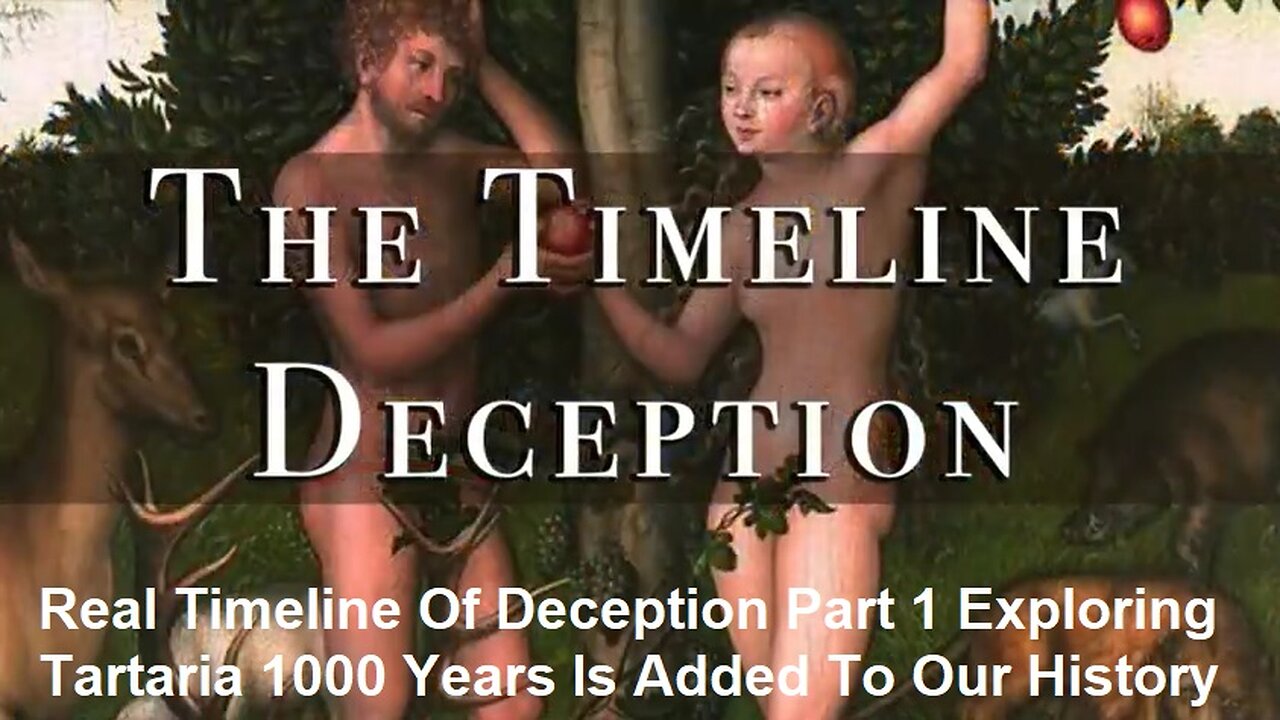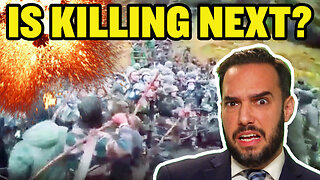Premium Only Content

Real Timeline Of Deception Part 1 Exploring Tartaria 1000 Years Added To Our History
Welcome To "Exploring Tartaria", where we will explore the Old World Pt. 1 through the lens that we are looking back on the Millennial Kingdom of Jesus Christ! This is not and I'am not a Hollywood Studio. ( She Did A Great Job Everyone) I explain that "Tartaria" was the Millennial Kingdom of Jesus Christ, and that we live at the end of the post-Millennial "Little Season". Thank you to everyone who has researched Tartaria, from lot's forums, and other info. Now let's gain even more knowledge and wisdom by understanding that we are looking back at the Millennial Kingdom! There are so many incredible things to discover. I believe you will enjoy looking at the relics of our past even more with this understanding!
Real Timeline Of Deception Part 0 Exploring Tartaria 1000 Years
Exploring Tartaria - Old World Secrets Revealed
Real Timeline Of Deception Part 1 Exploring Tartaria 1000 Years
The Timeline Deception - Part I - Exploring Tartaria
Real Timeline Of Deception Part 2 Exploring Tartaria 1000 Years
The Timeline Deception - Part II - Exploring Tartaria
Real Timeline Of Deception Part 3 Exploring Tartaria 1000 Years
The King of Tartaria - Exploring Tartaria
Real Timeline Of Deception Part 4 Exploring Tartaria 1000 Years
The Saints - Relics, Reliquaries, & The First Resurrection
Real Timeline Of Deception Part 5 Exploring Tartaria 1000 Years
The Saints - The Ruling Class - Exploring Tartaria
Real Timeline Of Deception Part 6 Exploring Tartaria 1000 Years
From Atheism, Agnosticism, New Age, Protestantism, to Roman Catholicism
Real Timeline Of Deception Part 7 Exploring Tartaria 1000 Years
The Millennial Kingdom of God - Exploring Tartaria
Real Timeline Of Deception Part 8 Exploring Tartaria 1000 Years
Magic of the White City 1893 Chicago World's Fair
Real Timeline Of Deception Part 9 Exploring Tartaria 1000 Years
1000 Years Added To Our History & Dark Ages Never Existed
Real Timeline Of Deception Part 10 Exploring Tartaria 1000 Years
Church History - Complete Documentary AD 33 to Present
Real Timeline Of Deception Part 11 Exploring Tartaria 1000 Years
Christmas Unveiled - Pied Piper - Templars Secret - Saturn's Workshop - Giants Stealing Children
Real Timeline Of Deception Part 12 Exploring Tartaria 1000 Years
Ancient Cloning Factories - Foundlings - Incubators - Test-Tube Babies
Real Timeline Of Deception Part 13 Exploring Tartaria 1000 Years
Homunculus Unveiled - Jesus - Artificial Generation - Liber Vaccae - Lost Esoteric Secrets
I got over what I refer to as the "dual timelines" and go into a little detail about how they relate to each other. I try not to bore you with too many examples and technical details, but hopefully you get the idea!
I also go over a few of the more major questions that you may have from Part I. There are some other more pertinent questions that I did not include, such as what is the "Rapture", and what was the Mudflood. I will throw out my theory on the Mudflood down the line. As far as the "Rapture" goes, please re-read 1 Thessolonians 4:17, and you tell me! Could the mortals at the end of the Kingdom be the ones who "meet the Lord in the air"? I'm not sure as I still can't quite make out what the Apostle Paul was trying to tell us.
As far as a more detailed explanation of the Tribulation being in our past, I may not be able to get to making that video in the near future. I know many of you have a lot of questions about all the various prophecies from the Old Testament as well as the New Testament. That is a very big subject and one that a person could devote a whole channel to. If you look into "preterism", you will find that many people have already answered a lot of those questions. They may not have understood the Kingdom of God was a physical kingdom in our past, so sometimes their timelines and interpretation of scripture can go off into a weird place (though you can't blame them because we were all deceived, and God has revealed this to us now). Still, there are valuable resources out there from preterist websites who go very in-depth about all of the various parts of scripture from both the OT and NT. It is a very big subject and one that will take a lot of time to get to, so please explore the resources out there that are already available in the meantime!
Again, thank you to all of those who have researched in this field. I'm not going to list names because I don't want to leave anyone out. But I'm familiar with the majority of the characters in the Alternative History scene, and I appreciate all of your work very much :) And a special shoutout to my dear friend Nicholas, who has been a great researcher in this field, and has helped me to arrive at some of these conclusions as we hashed out ideas over the past 2 years through TTT (Tartaria Text Time). Thanks so much! Hope you enjoy
I ask the simple question: If Jesus Christ was a literal king on earth for a continuous 1,000 years, then is there any evidence that shows him in this role?
we look at the past with the understanding that the First Resurrection already occurred approximately 1200 years ago. The people who took part in this event received new bodies, and are now referred to as "Saints", meaning "Holy Ones". This group of people lived and reigned with Christ for 1,000 years, and still live to this present day, as they are now immortal. We take a look at relics, or the physical remains of Saints, and ponder the true importance of these objects, as it seems that relics truly act as a conduit between mortals and God.
I hope this information will give you a better foundation as you re-read the Bible, or read for the first time. I feel you will also gain a higher understanding of the Millennial Kingdom, or Kingdom of God, as the New Testament characters not only played major roles in establishing the early Christian communities, but continued their roles in the subsequent Kingdom.
Not all of the information can be found in the Bible. Some bits and pieces come from the early church historians, that are then corroborated by repetitive themes throughout the artwork of the Kingdom period. I have done my absolute best to be as accurate as possible. Of course there is so, so much more to learn about with each saint featured in this video. But I feel that this is a solid core that you can build upon as you explore Tartaria ;)
My favorite saint is Saint Paul. I think it’s cool that he was so smart that God picked him to write a lot of the most important book ever created. I like that St. Paul is very serious and has an obsessive personality towards a cause. At first he used this talent for destruction, but he was blinded by the enemy and God knew there was a good man in there. Then Paul used his fanatical nature for good and became a fearless evangelist in the face of intense persecution.
It’s interesting to me that Paul is still persecuted to this day, as the Enemy sows seeds of doubt about Paul’s writings, presenting tripping blocks even for Christians. It’s honorable to be persecuted by the Adversary, and even more so if it persists 1200 years into the future. I chose Paul as my patron saint, because to me, he is the Patron Saint of Based. I love you Paul!
Another saint who I love is Saint John the Baptist. I can’t quite peg what John’s personality is like, but whenever I see a painting of him I just feel an intense love for him that sometimes makes me well up with tears (haha). I’m also looking forward to painting lessons from Saint Luke, who I think of as the cool uncle I never had.
I love all of the saints so much and I love learning about their lives before and during the Kingdom, and the special jobs that God gave them based on their talents. I look forward to creating more content about the saints in the future, but for now, I will be moving into some other topics.
This is the story of my mental and spiritual journey up until this point in my life. I wanted to share it with you so that you will know that I was barely raised Protestant Christian, much less Catholic. My conversion into Catholicism has been the result of a difficult journey of ardently seeking the truth. Never did I think I would become a Christian, and when I did become one, never would I have thought that I would later become Catholic!
Yet another twist in the plot... Catholicism turns out to be the truth!
As Jesus said, we will know a good tree from a bad tree by the fruits they produce, so we must ask ourselves, could the Catholic Church be home to the world’s greatest art and architecture, yet still be guilty of all the egregious crimes it is accused of?
And as we look back at our past in the context of the Millennial Kingdom, do we see another form of Christianity that appears more dominant than Catholicism?
Was the Catholic Church the usurper of the Old World, or was it the architect?
I know that many of you will have a lot of questions. I know exactly what those questions are, and they will be answered in the videos to come!
Thank you to Our Father Who Art in Heaven for revealing these things to us!
✠ I believe the revelation of our true past is a gift from God during these strange days on Earth. Up until the last few years, we were blinded and could not see what was right in front of us all this time. Sure, we noticed that the art and architecture of the past were all very beautiful and made fine tourist attractions. As we looked up at the architecture of the Old World, we all wondered why we stopped building such beautiful things. Yet the impossible nature of these creations escaped us, and we could not see that miracles of God were sitting right in front of us all along!
✠ God has revealed these things to this generation. Why would he pick this generation? Well since God is a very rational man, it seems only logical that he would reveal these things to the generation that it would be most pertinent to. To a generation that needs to prepare physically, mentally, and most of all-- spiritually, for what is to come. A generation who live through the final prophecy of Revelation, a final battle of some sort, and who will be alive on Judgment Day.
That is why I believe that this is a Revelation for the Last Generation.
✠ God showed us compassion and mercy by revealing the truth of our past, and for that I am very grateful. My life would be so much different if I didn't understand where we are in time and what was unfolding today. My physical preparations are in order and I will spend my final days on Earth 1.0 working on this ministry. I will gladly be your Friendly End Times Guide :)
Here are the videos that are coming up next on this channel:
✠ The True Origin of the Catholic Church
✠ The Celestial Hierarchy (Angelology)
✠ Greek Mythology (Likely a 3 part series)
✠ The Nature of Satan & the Kingdom of Darkness
https://www.youtube.com/@ExploringTartaria/playlists
I am looking forward to creating this content for you!
✠ P.S. In the future, I will do a video on the Battle of Gog and Magog and how we should prepare. But I will tell you now that I believe the "camp of the saints/ beloved city" may be up at the North Pole, which seems to be the location of the Garden of Eden. It is just my own prediction that we will be told that aliens have landed at the North Pole and all nations must be gathered to battle for our home. When this begins to unfold (and it appears that the narrative has already begun), you will not want to leave your home. I believe if you can stay home, and live in at least a moderately safe area, you will be okay. You should take preparations seriously, and have extra stock of all supplies that can last several months. You will not want to go out to Walmart when this starts to go down. God has revealed these things so we can prepare. These are my own opinions and I'm not a prophet, but I heed my own advice. I don't know the timeframe of all of this, but I certainly don't see myself becoming an old lady. It could be a couple years. It could kick off next month. I don't know, but please prepare. You know what you need to do! Blessed are those servants whom the master finds on watch when he returns. Luke 12:37
From New Age to Witchcraft to Jesus! - https://youtu.be/AU5-fZD89xM
Just So Everyone Knows! I’m aware of the Virgin Mary idolization that happens in the Catholic Church (I wasn’t aware before filming this video) and shortly after this video I threw away this curtain. Thank you. Britta Pipkin !
Biblical Eschatology is the study of what the Bible says is going to happen in the end times. Many treat Eschatology as an area of theology to be avoided. Of course, Eschatology is not as crucial as Christology or Soteriology. That does not mean, though, that it is unimportant to a Biblical worldview.
Eschatology is an often misunderstood but vital subject in Biblical studies. Let's take a look at its basic ideas and some of the misconceptions that people have about it. Eschatology is a word most Christians are likely obsessed with… and may not even know it.
The word has everything to do with the End Times, i.e., Jesus’ second coming. And many believers have different theories under which they operate.
We won’t waste much time in this introduction, as there is so much to unpack. Today we’ll uncover the biblical meaning of eschatology, its importance in Christianity, and much more.
What Is the Biblical Meaning of Eschatology?
Escatology, when we break the word down, means “last things” or “end.” Escha is Greek for “last” or “farthest,” as in the last thing on a spectrum, and ology always means “the study of.” When we put the words together, we get “the study of last things.”
Typically when Christians think of the word eschatology, they think of the Book of Revelation. You’d be completely correct if you operate under this assumption. All twenty-one chapters of Revelation point to things to come (although we could argue that the letters to the seven churches were also written to literal churches—not just future churches that are either operating now or in the future).
But did you know that throughout the Bible, we also see hints at the times to come?
Where Does Eschatology Appear in the Bible?
We see glimpses of “the last things” throughout the Old and New Testaments. Jesus brought up eschatology several times in his sermons. Although we can’t break down every instance of the study of end times in the Bible, I’d love to give a sampling of them below to show the breadth of the subject.
1. Daniel 9: The antichrist is described in great detail (although some believe that Antiochus Epiphanes, Nero, or other controversial figures played a precursor to this). He will attempt to thwart God’s plans, hurt God’s people, and try to turn the world against God.
2. Zechariah 14: A great battle is described, hinted more in detail in the battle of Armageddon in Revelation.
3. Acts 1: Jesus is described as returning, according to an angel, right after Jesus’ ascension. Jesus’ second coming plays a major role in eschatology.
4. Matthew 25: The author discusses eternal punishment and reward befalling unbelievers and believers, respectively. These subjects are further drawn out in Revelation 20.
5. 2 Peter 3: In the last days, several skeptics will question Christians. They’ll say, “You claimed that Jesus is coming back, but where is he? Maybe you were completely wrong.”
There are plenty of other examples we can point to, but I highly recommend checking out these verses as well. Several biblical books allude to the second coming of Christ and the events that will take place at the end of the old earth and old heavens.
Recognizing the Bible has many passages pointing to the end times, we must understand that many passages are vague or symbolic. For instance, Daniel describes one final empire (the one ruled under the antichrist) as a horrible beast with several horns. We know the beast will not be a literal Godzilla that rules (although the beasts described in Revelation certainly seem like it). Because some of the nature of eschatology is enigmatic, it can be hard to figure out exactly what will happen—especially since only God knows the time and place when these events will happen (Matthew 24).
What Are Different Types of Biblical Eschatology?
There are several different theories as to the nature of eschatology. Since the end times’ events occur in the future, we can’t fully know what will go down. Furthermore, honestly, all of these theories have issues that can be debated or discussed.
Before diving into the theories, we need to understand a few important events mentioned in the Bible. These will be presented in no particular order, as different views on escatology differ on when the events will occur.
1. Tribulation: Christians undergo intense trials under the antichrist and his followers. We can imagine this will result in distress, torture, death, and martyrdom.
2. Second Coming: At one point, Jesus will return. Believers are described in 1 Thessalonians 4 as meeting him up in the sky. Trumpets will announce his arrival, and he will be arriving on a white horse.
3. Millennium: Christ and his followers will rule for 1,000 years. Satan will be kept bound for a set period. Millennialists debate whether the 1,000 years are literal or figurative.
4. Final Judgment: Satan will break loose and plan a war on the followers of God and Jerusalem. At this time, God will defeat Satan and his armies and proceed with the final judgment. Unbelievers will experience the second death, and Satan and the unholy trinity will be thrown into the Lake of Fire. The old earth and old heavens will pass away, and God will introduce the new earth and new heavens.
In this article, we won’t have time to break down each of the four major key points listed above. But let’s see how the four main theories of eschatology address these.
What Are the Four Main Theories of Eschatology?
We will not indicate which theory is most biblically accurate. Each theory has advocates who can cite verses they are drawn to in Scripture and reasons why they believe what they do.
1. Amillennialism
The millennium is happening right now → Final judgment of Christ
Amillennialism believes that the millennium is symbolic and has been happening since Jesus ascended into heaven. Because of this, no rapture happens in the amillennial view. After the millennial reign ends, Jesus will come to judge the living and the dead. As mentioned in the “What Is Amillennialism?” article linked above, this view seemed to grow in popularity around the time of Augustine.
2. Postmillennialism
Symbolic Millennium through which Jesus’ kingdom is advanced through the gospel → Second coming and judgment
It’s often difficult to distinguish between amillennialism and postmillennialism since they both believe in a symbolic rather than literal millennial reign. They both believe it signifies a long period. The difference lies in postmillennials’ positive outlook. Postmillennialists believe that Christians will be able to advance the gospel and reach the most souls for Jesus. In contrast, amillennialists and premillennialists put more emphasis on Satan’s grip on the human world.
Speaking of premillennialists…
3. Premillennialism
Tribulation → Christ returns → 1000-year reign → Final judgment
This seems to be one of the most popular views amongst Americans. They believe a time of tribulation and apostasy will occur before Christ steps in, before the 1,000-year reign takes place. Premillennialists differ on when Christ returns. Some say at the end of the tribulation, and some say in the middle of the tribulation. No matter what the case, premillennialists believe that Christians will undergo suffering for a while before Christ steps into the picture.
4. Dispensationalism
Jesus returns and raptures believers → Those who come to Christ after rapture undergo tribulation → Jesus returns for the rest of the believers → 1,000-year reign → Final judgment
If you’ve read the Left Behind series, you have a good idea of this viewpoint. Dispensationalists follow the same basic chronology as premillennialists, leading some people to describe dispensationalism as a subgroup of premillennialism. However, dispensationalists have a particular twist: they believe Christians will be taken up (raptured) before the tribulation starts. Only those left behind, who come to Christ, will endure the antichrist’s hardships.
No matter what view a Christian takes, we all tend to agree that Christ will come again to finalize his kingdom and that a final judgment will take place after a millennial reign.
Why Is Eschatology Important to Christianity?
Christianity revolves around eschatology. We know that Christ died for our sins, and we can be saved through the power of his resurrection. But the story doesn’t end there.
Even after his death and resurrection, the world continues to be broken. People continue to reject his Lordship.
We have hope because we know that the world will not continue to remain broken. That God has a restoration plan. Although we can bring pockets of heaven to earth now, God will do so in full at the End of Days. He will restore the Garden of Eden and plant the tree of life again.
Eschatology—the study of the End Times—gives us hope that the country of our own (new heaven and new earth) that we’ve been yearning for will be instituted.
What Are the Dangers of Eschatology?
While eschatology gives us hope for the future, some Christians can get too obsessed with the end times (or, in some cases, not obsessed enough). Below are some of the dangers that come with eschatology—and why we should exercise caution.
Too Obsessed: Some believers may try calculating the 70 weeks mentioned in Daniel. They’ll try to do the math to figure out the exact date when Christ will return. Scripture tells us that only God knows. And in the meantime, we have a mission. If we become too obsessed with the End of Days, we may forget what we’ve been called to do now. To preach the Gospel to the ends of the earth. Until all nations hear the word, Christ won’t return.
Too Apathetic: Some believers have “fallen asleep” metaphorically on eschatology. They live for now, forgetting that we are also supposed to be future-minded. No, we shouldn’t constantly worry about whether Christ will return in the next minute. We don’t know the hour or minute he will come back. But we should be watchful. We should recognize the signs of the End Times and await with eager anticipation.
Too Mean: Although we shouldn’t water down the gospel—and eschatology is part of the gospel—there are some Christians who will take it to the next level. They will embrace the turn-or-burn message and tell people they must believe or end up in the Lake of Fire. Don’t get me wrong; we should warn people about the dangers of sin and not turning to Jesus. But we need to be mindful of methodology. A message rooted in fearmongering is not Christlike nor in line with the tone of the Gospel (2 Timothy 1:7).
Eschatology plays an important role throughout the Bible. Humans, and Satan, broke the world. And God will soon come to restore it and to restore us.
In the meantime, we need to press on in our current mission. We’re not done yet, Christians. Let’s continue to advance the gospel and leave the End Times to God. We’ll know when he arrives. In the meantime, let’s focus on what he’s called us to do.
Biblical Preterism is a Christian eschatological view that believes that all prophecies in the Bible have already been fulfilled in the past. This school of thought interprets the Book of Daniel as referring to events that happened from the 7th century BC until the first century AD, while seeing the prophecies of the Book of Revelation as events that happened in the first century AD. Preterism is directly opposed to futurism, which sees the end-times prophecies as having a still-future fulfillment. Hyper-Preterism, the belief that the New Testament expectation of Christ's return in glory has already occurred, has become a fairly standard part of critical approaches to biblical faith as they have developed during the modern period.
Revelation 20-20-21-22 The Thousand Year Reign
20 Then[a] I saw an angel descending from heaven, holding[b] in his hand the key to the abyss and a huge chain. 2 He[c] seized the dragon—the ancient serpent, who is the devil and Satan—and tied him up for a thousand years. 3 The angel[d] then[e] threw him into the abyss and locked[f] and sealed it so that he could not deceive the nations until the one thousand years were finished. (After these things he must be released for a brief period of time.)
4 Then[g] I saw thrones and seated on them were those who had been given authority to judge.[h] I also saw the souls of those who had been beheaded because of the testimony about Jesus and because of the word of God. These[i] had not worshiped the beast or his image and had refused to receive his mark on their forehead or hand. They[j] came to life[k] and reigned with Christ for a thousand years. 5 (The rest of the dead did not come to life until the thousand years were finished.)[l] This is the first resurrection. 6 Blessed and holy is the one who takes part[m] in the first resurrection. The second death has no power over them,[n] but they will be priests of God and of Christ, and they will reign with him for a thousand years.
Satan’s Final Defeat
7 Now[o] when the thousand years are finished, Satan will be released from his prison 8 and will go out to deceive[p] the nations at the four corners of the earth, Gog and Magog,[q] to bring them together for the battle. They are as numerous as the grains of sand in the sea.[r] 9 They[s] went up[t] on the broad plain of the earth[u] and encircled[v] the camp[w] of the saints and the beloved city, but[x] fire came down from heaven and devoured them completely.[y] 10 And the devil who deceived[z] them was thrown into the lake of fire and sulfur,[aa] where the beast and the false prophet are[ab] too, and they will be tormented there day and night forever and ever.
The Great White Throne
11 Then[ac] I saw a large[ad] white throne and the one who was seated on it; the earth and the heaven[ae] fled[af] from his presence, and no place was found for them. 12 And I saw the dead, the great and the small, standing before the throne. Then[ag] books were opened, and another book was opened—the book of life.[ah] So[ai] the dead were judged by what was written in the books, according to their deeds.[aj] 13 The[ak] sea gave up the dead that were in it, and Death[al] and Hades gave up the dead that were in them, and each one was judged according to his deeds. 14 Then[am] Death and Hades were thrown into the lake of fire. This is the second death—the lake of fire. 15 If[an] anyone’s name[ao] was not found written in the book of life, that person[ap] was thrown into the lake of fire.
Preterism comes the Latin word ‘praeter’ which means ‘the past’. When it comes to understanding Bible prophecy all Christians are preterists to one degree or another. It is only logical and reasonable to examine the past to see if a prophecy has already been fulfilled. Most Christians would acknowledge that Isaiah 7:14 describing a virgin giving birth has been fulfilled in the past. But not all Christians would agree about the nature of prophecies relating to Christ’s “second coming”. Preterists argue that all of the prophecies relating to Christ’s ‘coming’ (as described in Matthew 24) have already been fulfilled. This contrasts with two other schools of prophecy interpretation.
Essentially there are then three general schools of eschatology:
Futurism – the contents of Revelation pertain to the very end of time on earth.
Historicism – that the contents of Revelation have unfolded throughout history from the time of its writing to the present day (and beyond).
Preterism – before assuming that a prophecy is not fulfilled, it should be evaluated in the light of the past. That is, how did the original audience understand what was written to them – and what was the original intention of the text. If it can be demonstrated that a prophecy has been fulfilled in the past, then that prophecy should be considered as fulfilled prophecy.
Within Preterism there are two streams. Both streams identify themselves as “Preterist”. To distinguish between them, two pejorative terms are often employed: Hyper-Preterism, and Partial-Preterism. Full Preterists, also referred to as Hyper-Preterists, or Pantelogists, regard all Bible prophecy fulfilled by A.D. 70. Those who regard that most prophecy was fulfilled by A.D. 70 (including the parousia of Christ’s Vindication, the commencement of the Kingdom of Christ, the First Resurrection, but not including the Final Judgment, the banishment of Satan to eternal torment, or the General Resurrection) are referred to as Partial-Preterists or more correctly: Classical Preterists. The proceeding table of comparison between Full-Preterism and Partial Preterism will highlight the differences.
Criticism of Preterism can be summarised as-
Futurists – claim that Preterism ‘spiritualises’ Bible prophecy rather than taking it literally.
To which Preterists counter that they are actually more literal in their interpretation of Bible prophecy because they strive for the original intention of a passage rather than impose fanciful modern understandings onto an ancient text.
Historicists – claim that Preterism was developed by Jesuits in the seventeenth century to counter the growing the Reformation claims that the Papacy was the Anti-Christ.
This is actually one of the weakest methods of debate: attack with innuendo and name calling and ignore the content of the proposition. The roots of Preterism go back to the First Century AD when people clearly saw the events foretold by Christ as having been fulfilled up until the destruction of Jerusalem and Judea in A.D. 70. The sticking point between Full-Preterists and Partial Preterists is the nature of the Resurrection. Resolve this issue Biblically and you will conclude that one of these two positions is thoroughly Biblical and (while Creeds are not authoritative) in agreement with the earliest Creeds of the Church.
Many Christians have strong beliefs about the Second Coming of Jesus Christ. However, they don’t talk as much about what will happen after He returns. But the Bible tells you what is in store during and after the greatest event in human history.
There are actually dozens of clear, detailed Bible prophecies showing that, after Christ returns, a 1,000-year period will occur, during which He will rule the Earth with the saints. Many Christians downplay this millennium or regard it as being “spiritual” but not literal.
What is the Millennium? Is there really a prophesied time of worldwide peace and prosperity just around the corner? Will Jesus Christ really return to Earth to set up a world-ruling government? The answers to these questions are plainly revealed in your Bible.
Read the writings of historians and theologians from the first few centuries after Christ’s death and resurrection, and you will see that they were generally aware of His future 1,000-year reign on Earth. Papias of Hierapolis taught in the second century a.d. that “there would be a certain millennium after the resurrection, and that there would be a corporeal reign of Christ on this very Earth,” according to the famous historian Eusebius’s Ecclesiastical Histories (emphasis added).
Irenaeus, the bishop of Lyons, wrote in the second century a.d.: “For in as many days as this world was made, in so many thousand years it reaches its consummation.” He identified several Old Testament passages that refer to the Millennium, then continued: “All such things refer not to heavenly matters but to the time of the kingdom, when the Earth has been restored by Jesus Christ.”
These men took the many biblical prophecies and statements about the Millennium literally. They did not think that this Kingdom of God was set up only “in your heart.” They understood it to be the literal reign of Jesus Christ on Earth, a government just as real as ancient Israel, the Roman Empire or the United States. Today, however, that general understanding of the Millennium has been lost.
What is the truth?
First, understand that this is not God’s world. The god of this world is actually Satan the devil (2 Corinthians 4:4). He has deceived the entire world through his powerful broadcast as the prince of the power of the air (Revelation 12:9; Ephesians 2:2).
Revelation 20:1-3 prophesy that after Jesus Christ’s return, Satan and his demons will be bound for a thousand years: “And I saw an angel come down from heaven, having the key of the bottomless pit and a great chain in his hand. And he laid hold on the dragon, that old serpent, which is the Devil, and Satan, and bound him a thousand years, And cast him into the bottomless pit, and shut him up, and set a seal upon him, that he should deceive the nations no more, till the thousand years should be fulfilled: and after that he must be loosed a little season.”
This shows that after Christ takes the throne of the Earth from Satan, he will be restrained, no longer able to deceive the nations, for a thousand years. That tells us that the Millennium is a future event, because the world right now is clearly still heavily influenced by Satan. When that evil spirit influence is removed, however, everyone will have the opportunity to receive the wonderful truth that God reveals in the Bible. Everyone will finally have the opportunity to learn the way to true happiness. “[T]he earth shall be full of the knowledge of the Lord, as the waters cover the sea” (Isaiah 11:9). This is the time of “refreshing” and the “restitution of all things” prophesied in Acts 3:19-21.
In the Millennium, the saints of God will rule with Jesus Christ (Revelation 20:6; Daniel 7:18, 27; Revelation 3:21; 5:10). These resurrected saints will rule beside Jesus Christ as His Bride (Revelation 19:7-8).
In the fourth century a.d., the Catholic Church removed the book of Revelation from its general reading list. Encyclopedia Britannica (11th edition) comments: “Thus the troublesome foundation on which [the teaching of the Millennium] might have continued to build was got rid of.”
Edward Gibbon wrote in The Decline and Fall of the Roman Empire: “The doctrine of Christ’s reign upon Earth … was considered by degrees as a doubtful and useless opinion, and was at length rejected as the absurd invention of heresy and fanaticism.”
The Catholic Church began to look on the Roman Empire as the fulfillment of the Kingdom of God. It erased the teaching of a future kingdom to be established by Christ at His return. Today, the pope of the church in Rome is called the vicar of Christ—in place of Christ. Many in Catholicism and the churches that derived from Catholicism believe that Christ’s millennial reign has already begun in some way. However, Revelation 20 clearly shows that the Millennium cannot begin until after Satan has been removed and bound.
Today, we are so far removed from the truth about the Millennium that many Christians don’t believe this doctrine is even taught in the New Testament. But note this in John 7:8: Jesus Christ encouraged His disciples and His family to go and keep the Feast of Tabernacles. “But when his brethren were gone up, then went he also up unto the feast, not openly, but as it were in secret. Then the Jews sought him at the feast, and said, Where is he? … Now about the midst of the feast Jesus went up into the temple, and taught” (verses 10-11, 14).
Jesus Christ set this example for us: Even at the peril of His life, He kept the Feast of Tabernacles so that we might follow in His steps (1 Peter 2:21).
Why keep the Feast of Tabernacles? To understand the truth about the Millennium!
The Feast of Tabernacles is the sixth of seven annual festivals that God commands His people to observe every year. This weeklong fall festival occurs in September or October. Deuteronomy 16:14 shows that during the Feast of Tabernacles, God wanted the ancient Israelites to overflow with joyfulness, thanksgiving and rejoicing. God even commanded the Israelites to save a tenth of their income throughout the year for use at this festival to help them rejoice. Deuteronomy 14:23 gives the purpose of the Feast and its abundance: “[T]hat thou mayest learn to fear the Lord thy God always.” This Feast pictures a time of physical abundance, when the whole world will enjoy the fruits of obeying God’s law.
Exodus 23:16 calls the Feast of Tabernacles a “feast of ingathering.” God’s plan of salvation is typed by the two annual harvests in ancient Israel: the small spring harvest of the firstfruits of the crops, and the much larger fall harvest. These harvests type God’s time order for harvesting human beings into His Family: First, He is gathering in a small harvest of firstfruits—the Church, which is being prepared and trained so they might rule with Christ in the Millennium and beyond. Then, God will gather in the great fall harvest, when all who have ever lived will be given a chance to be part of God’s Family. The Feast of Tabernacles pictures that future ingathering of Spirit-begotten humans who will be brought into the Family of God during the 1,000-year reign of Christ.
The Feast of Tabernacles pictures a time when God’s Family will be enlarged. That is why Christ observed this festival when He was on Earth—because He understood what it pictured, even if the Jews did not.
Zechariah 14 shows that when Christ returns, mankind will try to fight Him, but He will forcefully put down all rebellion. Mankind will be forced to be happy—to live the way of God, which brings real happiness into our lives. At that time, “living waters shall go out from Jerusalem; half of them toward the former sea, and half of them toward the hinder sea: in summer and in winter shall it be. And the Lord shall be king over all the earth: in that day shall there be one Lord, and his name one” (verses 8-9). God’s law will flow out from Jerusalem (Isaiah 2:3), and this city will become the joy of the whole Earth (Psalm 48:2).
Zechariah 14:16 shows that in the Millennium, everyone will keep the Feast of Tabernacles: “And it shall come to pass, that every one that is left of all the nations which came against Jerusalem shall even go up from year to year to worship the King, the Lord of hosts, and to keep the feast of tabernacles.”
Talk about a feast of ingathering! This foretells a time when all mankind—Israelites and Gentiles alike—will be keeping the Feast of Tabernacles in Jerusalem. All mankind will be obeying God’s law and keeping His annual holy days!
After putting down the initial rebellion, Christ will begin a massive project of reeducation. Much of that reeducation will center around these seven annual festivals, which picture God’s master plan for mankind. God commanded for these festivals to be observed forever. That is why Christ risked His life to keep them when He was on Earth—because He knew that these holy days pictured a time when all mankind would be brought into the Family of God. In this soon-coming Kingdom of God, everyone will have access to God’s truth and will be able to learn the way to true happiness. The truth of God will cover the Earth like the waters cover the ocean beds! (see Isaiah 11).
Zechariah 14:17-19 show what will happen to those who refuse to keep the Feast of Tabernacles. They will experience curses from God such as drought until they change their attitudes. What more proof do we need that God always intends for us to keep these days?
Now 6,000 years of human experience have brought mankind to the very brink of world suicide. So, in other words, the first 6,000 years of God’s 7,000-year plan were allotted to allow Satan to labor at his work of deceiving the world, followed by 1,000 years (one millennial day) when Satan shall not be allowed to do any of his “work” of deception. Put another way, God marked out six millennial days to allow man to indulge in the spiritual labor of sin, followed by a millennium of spiritual rest, under the enforced government of God.
There is some people who believe that 800-1000 years are added to our History and that fall of Rome and Jesus Christ happened much faster then we think . I tried to research this and found one great article about Italian Umberto Gallery which in 19th century photos did not have first letter M which means it is 1000 years older . Then i found some interesting coins from the past .
1000 Years Added To Our History?
Dark Ages Never Existed?
Has Our History Been Tampered With?
https://muslimheritage.com/uploads/AboutUs.pdf
Believers in the “Tartaria” conspiracy theory are convinced that the elaborate temporary fairgrounds built for events like The Chicago World's Fair of 1893 and the Panama-Pacific International Exposition in San Francisco in 1915 were really the ancient capital cities of a fictional empire. Built in the 1920s?, the Hong Kong and Shanghai Bank was one of several ornate Western-style commercial buildings in Shanghai’s Bund district.
Inside the ‘Tartarian Empire,’ the Architecture boards, adherents of a bizarre conspiracy theory argue that everything you know about the history of architecture is wrong. In 1908, architect Ernest Flagg completed the Singer Building in Lower Manhattan, a Beaux-Arts showstopper made for the Singer sewing machine company. From a wide base, a slender 27-story tower rose, topped by a mansard roof and a delicate lantern spire.
Every inch dripped with sumptuous detail inside and out; vaulted roofs, marble columns with bronze trim, window mullions with spiral fluting. The lobby was said to have a “celestial radiance.” A book was written just about its construction. For a year, it was the tallest building in the world at 612 feet, and a celebrated landmark for decades after that.
But not for too much longer. Despite its great height, the pencil-thin tower lacked office space. In the 1960s the company sold its ornate headquarters; demolition proceeded in 1967. It’s the tallest building to ever be peacefully demolished.
By any account, it’s a fantastical tale: Once the tallest building in the world and a New York icon, knocked down in just a handful of decades.
For some, it’s too fantastical to believe … or perhaps not fantastical enough. A dedicated group of YouTubers and Reddit posters see the Singer Building and countless other discarded pre-modern beauties and extant Beaux-Arts landmarks as artifacts of a globe-spanning civilization called the Tartarian Empire, which was somehow erased from the history books. Adherents of this theory believe these buildings to be the keys to a hidden past, clandestinely obscured by malevolent actors.
Who? Why? To what possible end? As in many other, more high-profile conspiracy theories, this baroque fantasy doesn’t offer much in the way of practical considerations, logic or evidence. But it’s grounded in some real anxieties, pointing toward the changes wrought by the modern world in general and modern architecture specifically — and rejecting both.
Tartaria rises
Tartarian-themed content is produced for YouTube videos that get picked over on Reddit. The r/Tartarianarchitecture sub, which began in December 2018, has 3,300 members, though not everyone who posts and comments appears to be a true believer. A larger and more general sub that appeared around the same time, r/Tartaria, has 8,700 members. As conspiracy theories go, Tartaria remains obscure; Twitter user @cinemashoebox brought it to many people’s attention last year with this thread, and pseudoscience-debunking writer Brian Dunning recently devoted an episode of his podcast, Skeptoid, to the Tartaria theory, which appears to have first emerged in 2016 and 2017.
The Tartaria storyline is not directly related to the adrenochrome-harvesting Satanic-pedophile cabal that lies at the heart of QAnon, the unfounded conspiracy theory that crashed into the real world in 2020. But it shares some of what Peter Ditto, a social psychologist at the University of California-Irvine who specializes in conspiracy theories, calls QAnon’s “cafeteria quality:” There’s no overarching narrative or single authorial voice interpreting events. It’s just a gusher of outlandish speculation; adherents can pick and choose which elements they want to sign on to.
The overall premise is an alternative history. A vast, technologically advanced “Tartarian” empire, emanating from north-central Asia or thereabouts, either influenced or built vast cities and infrastructure all over the world. (Tartaria, or Tartary, though never a coherent empire, was indeed a general term for north-central Asia.) Either via a sudden cataclysm or a steady antagonistic decline — and perhaps as recently as 100 years ago — Tartaria fell. Its great buildings were buried, and its history was erased. After this “great reset,” the few surviving examples of Tartarian architecture were falsely recast as the work of contemporary builders who could never have executed buildings of such grace and beauty, and subjected them to clumsy alterations.
“I think that it was one worldwide civilization,” says Joachim Skaar, a 26-year-old Norwegian who runs The Tartarian Meltdown YouTube channel. “It was all based on unity, oneness, peace, love, and harmony, which we don’t see in today’s society.”
There’s an arch-traditionalism present in the theory, too. The pre-modern buildings that we venerate are sometimes said to be more than 1,000 years old. “The same people that built the Capitol in Washington built the pyramids in Egypt,” Skaar says.
Reached at his recording studio, Skaar, who works as a plumber, is not an architect or historian, but he has strong opinions on both disciplines. “We have two very different types of architecture,” he says. There’s modern architecture “with the name Brutalism,” which he describes as “square concrete boxes which are designed to be produced very fast, very cheap and very effective.”
And then there’s Tartarian architecture, a label that gets applied to anything that’s particularly ornate and pre-modern, encompassing many Western styles: Classical, Beaux-Arts, Second Empire. The term is also sometimes used for some non-Western structures, like the Taj Mahal. Structures that seem geographically or culturally dislocated, like the Beaux-Arts commercial buildings in Shanghai’s Bund district, are particularly attractive to this theory, as are those that are impressively massive, like the pyramids of Egypt or the Great Wall of China (built, the theory goes, by Tartarians to keep the Chinese out). Anywhere there’s a perceived gap between the refined craftwork of an old building and the “primitive” technology of the horse-and-buggy-era people building it, space for Tartarian speculation pops up.
American cities of the 19th century are often rich with Tartarian appropriation, especially the young settlements of the West, when grand public structures seemed to emerge from the wilderness, surrounded by wood hovels and muddy streets. State capitol buildings and city halls are frequently fingered as palaces of ancient Tartaria rather than Gilded Age municipal buildings. (These photos of the Iowa State Capitol in Des Moines highlight the contrast Tartarian theorists point out.)
The Tartarian milieu is an intensely visual medium, occupied with riffing on photos and maps, picking out apparent inconsistencies and making one-off conjectures instead of weaving together comprehensive timelines. The theory is notably light on reasoning as to why and how the greatest cover-up in history was undertaken, but it does offer a few options for how Tartaria was erased and the great reset propagated. Many say that an apocalyptic mud flood buried its great buildings; some suggest the use of high-tech weaponry to tactically remove Tartarian infrastructure. A consistent theme is that warfare is an often-used pretext to wipe away surviving traces of Tartarian civilization, with the two world wars of the 20th century finishing work that may have begun with Napoleon’s invasion of Russia.
Despite their interest in architecture, most Tartaria theorists do not appear to have backgrounds in the building trades: Many of the more easily refuted arguments spring from very basic misunderstandings of how the built environment works, as well as broader confusion about how buildings function in the economy and culture. An abundance of posters appear convinced that below-grade basement windows in older buildings, for example, are evidence that the building had been “mud flooded,” and the rest of the structure is actually buried deep underground. Sometimes this will get some skeptical pushback (“I think they didn't have lights in the cellar so they build in windows for them?” was how one poster responded), but that’s more of an exception than the rule.
“You see these capital domes all over the world, which, to me, proves that the same people built everywhere.”
Similarly, their grasp of historic labor and material costs is shaky. Before the Industrial Revolution, labor was cheap, so paying artisans to sculpt elaborate masonry — even for relatively humble structures — wasn’t the great expense it seems today, when labor prices are higher and factory-made steel, concrete and glass is cheap; that’s why we see so much of these materials in buildings today, and so much less filigreed terra cotta. One of the most adamant denials in Tartarian circles is that public buildings like schools and post offices were ever built with monumental proportions and elegant aesthetics. They sneer at the wedding-cake-topper Second Empire buildings designed by Alfred Mullett after the Civil War, for example. “How many stamps did you sell to build yourself a post office like this?,” says popular Tartarian YouTuber JonLevi in one of his videos. “Absolutely ridiculous. The post office has always struggled.” (He has more than 100,000 subscribers.)
Some of this confusion is unfamiliarity: Mullett’s U.S. Customs House and Post Office in St. Louis, for example, was a huge federal project, built to process the mail of 10 states and four U.S. territories, not a neighborhood letter depot. But beyond that, there’s a broader refusal to believe that public architecture could ever have been built in an atmosphere of generosity and abundance. This is echoed by their astonishment at the double-height grand lobbies and arched doorways of old buildings, which they see as artifacts not meant for us. (Some theorists surmise that ancient Tartarians were giants.) The Tartarian community seems to have internalized the current era’s predilection for public sector austerity and the resulting aesthetics, which they abhor, more than they realize.
At its core, the theory reflects a fear of how quickly things change. As they look at today’s cityscapes, Tartaria believers see an eerie and alienating place, filled with abstract monoliths that emerged out of nowhere in a brief period of time. They’re skeptical of the rapid rise and development of the U.S., and even more suspicious of how quickly Modernism came to dominate the landscape. One favorite case study, useful for illustrating this aesthetic whiplash, is the grand domed Henry Ives Cobb Chicago Federal Building, built in 1905. Like the Singer Building, it was razed after just 60 years in favor of an icy black Mies van Der Rohe tower.
In one sense, the Tartaria theory is right: With modern architecture, a revolutionary new consensus on how the built environment should look and work did take hold in a very short period of time, conveniently overlapping with the world wars that these theorists see as the tail end of Tartaria’s influence. The world of 1960 indeed looked radically different from the world of 1920. Led by obscure and poorly understood forces (architects), architecture schools truly did throw out the history books to build a new world. But instead of making this excision the work of a colossal global mega-conspiracy worthy of a pulpy airport mystery novel, they wouldn’t shut up about it.
In the Tartarian worldview, we’re a society that doesn’t properly understand or value the built environment, because we’ve been misled about who really built it. When he’s decrying the lack of regard for the cultural legacy of old buildings, Skaar sounds less like a conspiracy theorist than a board member of a preservation nonprofit. “The problem is that people don’t recognize these buildings,” he says. “They walk past them all the time, and they’re fascinated, but they don’t think any more deeply about it. They don’t know what they’re looking at because they have been told something else.”
In search of a fabricated empire
This disregard for architecture’s “true” history moves into a wider rejection of how disposably cheap and commodified the culture at large seems to be. As such, one canonical belief of Tartarian aficionados is that the elaborate temporary pavilions built for late 19th century and early 20th century World’s Fairs were in fact Tartarian capital cities. It strikes them as improbably wasteful that anyone would erect these magnificent complexes, full of fluted columns, domes and pediments, out of plaster of Paris, hemp fiber, and straw, as was done for the 1893 World’s Fair in Chicago. In Tartarian lore, these sites were ancient monuments that were co-opted to teach a falsified history of the world and make a few bucks selling popcorn and Ferris Wheel rides. Then they were demolished, to erase the handiwork of the real builders.
In pointing out the eradication of an ancient culture by an expanding imperial power, Tartarian believers again stumble on something real, but they scramble the protagonists. In the European colonial era, Western nations fanned out over the globe, subjugating and destabilizing numerous non-white civilizations — and building many examples of what’s now considered Tartarian architecture as celebration of these victories. But when YouTuber JonLevi marvels at the Hong Kong Shanghai Bank and the rest of the 1920s banking infrastructure built along Shanghai’s Huangpu River, he doesn’t see the wealth-extracting handiwork of a rapacious 20th century empire: In the Tartaria-verse, these are the stately remnants of a far older and more benevolent one. The theory posits that only Tartarians, not British bankers or Belgian rubber barons, could move culture like architecture across geography.
“You see these capital domes all over the world, which, to me, proves that the same people built everywhere,” says Skaar.
Bastion star forts are another building type that Tartarians are obsessed with: They often point out that these cannon-resistant military fortifications, popular in the 16th and 17th centuries, are found all over Western Europe, like Portugal and the Netherlands, but also quite mysteriously, far away in Asia, in Sri Lanka. But since Sri Lanka was a Portuguese and Dutch colony, it’s not really very mysterious. Military historian Jeremy Black, author of two books on the history of fortifications, says that the geographic reoccurrence of the style reflects how effective Europeans were in spreading this technology across the globe.
This ahistoricism can make the Tartarian architecture community occasionally receptive to reactionaries, racists and anti-Semites. A survey of videos and discussions will turn up all manner of other conspiratorial threads. Along with flat-Earth advocacy, anti-vaccination sentiments and 5G scaremongering, there’s talk of anti-Semitic banking cartel conspiracies and Holocaust denial. Some Tartarian histories recast populations of Central Asia, like Genghis Kahn’s Mongol Empire, as red-haired, blue-eyed, white people — “Silk Road Aryans.”
The persistence of anti-Jewish tropes within current conspiracy theories is likely the result of cultural inertia, says UC-Irvine scholar Ditto. As successive generations of the conspiracy-minded seek evidence to back up their diverging worldview, they find it in texts that may go back centuries, which are riddled with anti-Semitism.
But the face of the villains in the Tartarian narrative is not clearly defined. Skaar blames quasi-mystical “parasites” who thrive off pain and strife, and laments that contemporary life has become a place where “everything is based on tyranny, greed, and slavery.” The Tartaria commentariat is laced with economic discontent; they often decry the evaluation and disregard of buildings purely as salable commodities, untethered from broader notions of cultural legacy and achievement. There’s a reoccurring and implicit understanding that buildings, like the Singer Building, get torn down when they stop making money — the only thing that really matters — and that the world is a vast field of predation, where the rich and powerful consume the poor and weak.
In fact, the governing ideology of the modern architecture that Tartarians despise was a critique of this system. Modernism argued for an egalitarian architecture that would help break the shackles of the past, rejecting backbreaking representational craftsmanship to honor omnipotent kings and divine beings in favor of simple, universal forms that would leverage restraint and efficacy into a broad uplift for the masses. Minus the weirdest stuff — the global mud flood, the ancient energy weapons, the vanished race of giants — the Tartaria theory is just an extreme form of aesthetic moralism, the idea that traditional architecture styles are inherently good and modern architecture is the product of a degenerate culture.
The tastes of the community generally align with traditional architectural revival proponents (some of whom also embrace reactionary and white nationalist politics). This sort of aesthetic nativism flourished during the Trump era, and it appears to have fresh converts in Congress: Recently, representatives Marjorie Taylor Greene and Paul Gosar formed a new caucus dedicated to “uniquely Anglo-Saxon political traditions” and infrastructure that “befits the progeny of European architecture.” The language is different, but the sentiment wouldn’t appear out of place in r/Tartaria.
Holding back a flood of conspiracies
Though the Tartarian Empire seemed to wink into existence in the past few years, the themes its believers explore are familiar ones. Conspiracy theories are a way to channel restive populism in the face of rapid social and demographic change, Ditto says, and there’s plenty of that going around. They are also a way to gather up amorphous fears and put them in a specific place, to make them more manageable. Ditto calls this “over-intentionalization.
“If your fate is controlled by impersonal, systemic forces, it doesn’t offer you much control over your own destiny,” he says. “But if you can localize it to a small group of people whose motives you understand — they are out to get you — then it at least offers some hope that you can overcome their malevolent intentions.”
Belief in conspiracy theories can also be driven by loneliness, isolation and economic hardship, which made a pandemic a fertile Petri dish, and helped QAnon’s believers storm the Capitol by force and through the ballot box. The social atomization forced on us by Covid-19 is a hyperbolic retelling of the Tower of Babel (which has a special place in Tartarian lore) and its attendant anxiety at fracturing and divided cultures. The great reset that erased that tower — and the fabulous, fictional empire that built it — continues to reverberate, splintering us into ever-stranger factions.
And Ditto says it does seem like reality is getting harder to decipher. The internet has made it easier to disseminate misinformation while eroding faith in the media hierarchies that once filtered it out. Polarization and a lack of trust in government and institutions creates a feedback loop, where leaders can’t solve problems because their political bases are too narrow, and the resulting failures engender more distrust. It’s not a new cycle — despite a spike in media attention, there’s not much evidence that conspiratorial thinking is more common now than in years past — but technology can make these currents of collective delusion more powerful, and harder to ignore.
The basic human desires for community, stories (the more outrageous the better) and the need to feel like a protagonist in a wider struggle are what pulls us from moments of real social, economic and cultural dislocation into fabricated histories. Buildings and cities are made to grow old, to outlast people, and to be a testament to these cultural histories. They’re a yardstick for a culture’s ability to endure. When they’re not given the chance to do this, the contradiction can break something loose, and send people scavenging for cultural memory that feels ancient enough to anchor them in an uncertain now.
-
 22:07
22:07
What If Everything You Were Taught Was A Lie?
7 days agoAmerica Remember Islam A Religion Peace & This What Muslim Did To Females Is Hard To Stomach
1.28K5 -
 LIVE
LIVE
Flyover Conservatives
20 hours agoInside the Kill Zones: Kidnappings, Camps & the War on Nigerian Christians Exposed - Judd Saul | FOC Show
307 watching -
 1:02:35
1:02:35
MattMorseTV
2 hours ago $13.92 earned🔴We just got the CONFIRMATION.🔴
14.6K34 -
 1:24:52
1:24:52
Glenn Greenwald
4 hours agoTrump Admin Preparing for New Regime-Change War Against Venezuela; Who Should Win Anti-Semite of the Year? See the Top 10 Finalists | SYSTEM UPDATE #551
92.8K52 -
 23:12
23:12
Jasmin Laine
6 hours agoCBC TURNS on Carney—Poilievre Speech Goes VIRAL, ROASTS Canada’s Elites
12.7K16 -
 1:16:21
1:16:21
The Daily Signal
5 hours ago $2.33 earned🚨BREAKING: Tim Walz Self-Destructs Over BILLIONS in Fraud Under His Watch, War Crime Allegations
14K2 -
 9:08
9:08
China Uncensored
8 hours agoIndia And China Are Headed To Another War
3.91K9 -
 12:04
12:04
Vedic compatability astrology
3 hours ago"My Persian grandmother's secret beauty potions now on Amazon"
3.02K -
 12:44:59
12:44:59
LFA TV
1 day agoLIVE & BREAKING NEWS! | MONDAY 12/01/25
205K22 -
 1:01:31
1:01:31
OFFICIAL Jovan Hutton Pulitzer Rumble
3 hours agoWhen Evil Masquerades As Patriots and Freedom! A Social Experiment
9.82K3